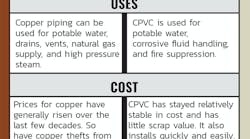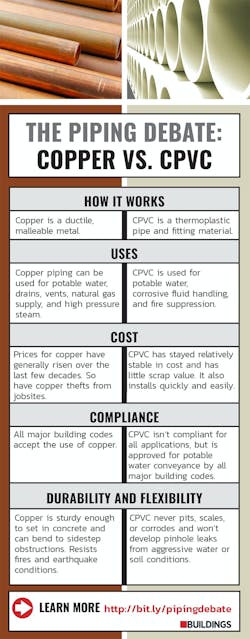Last updated on April 2, 2018.
In plumbing circles, there is a longstanding debate between copper and chlorinated polyvinyl chloride (CPVC) piping. Copper has been used in North American plumbing applications for more than 70 years. CPVC has been installed successfully for nearly 50 years. Which is best for your application? We present the information here and let you decide:
Copper is a ductile, malleable, reddish-brown metallic element that is an excellent conductor of heat and electricity, and is widely used for electrical wiring, water piping, and corrosion-resistant parts, either pure or in alloys such as brass and bronze.
Since 1963, more than 28 billion feet (or about 5.3 million miles) of copper plumbing tube has been installed in U.S. buildings. That’s equivalent to a coil wrapping around the earth more than 200 times. The current installation rate now exceeds 1 billion feet per year.
Copper has been used for plumbing and mechanical systems since metals were first employed in these types of applications. It has established its current reputation for long-term durability in installations because it’s light, strong, corrosion resistant, and available in rigid and semi-rigid forms. Because of its proven dependability, copper’s widespread acceptability ensures compliance with all major building codes.
In contrast, CPVC piping isn’t universally compliant. Some U.S. cities or states have specific restrictions on its use. Because of its relative “newness” in the industry when compared to copper, some facilities professionals fear CPVC installation due to the possibility of callbacks or lawsuits. CPVC just hasn’t been around as long, so some are leery of its durability.
In terms of pricing, many copper proponents assert the fact that labor costs oftentimes compensate for the difference in material costs between CPVC and copper. Although installation in some applications may be easier with CPVC, copper is much more durable on the jobsite (CPVC pipe and fittings are subject to cracking or breaking if dropped, stepped on, or not handled carefully, and must be stored properly to prevent UV degradation). Copper may also be more sturdy than CPVC once it’s installed; it withstands earthquake conditions (CPVC may not) and is very fire resistant. Copper’s high melting point is 5-times higher than CPVC’s, so it can withstand much hotter temperatures. Copper won’t burn or support combustion, and won’t carry fire through floors, walls, or ceilings.
Copper is also a very versatile material. It can be used for potable water supply, drain/waste/vent applications, natural-gas supply, high-pressure steam applications, etc. Copper systems don’t have a reputation for responding well to hard well water, soft acidic water, aggressive soil conditions, or excessive water velocity in the piping line. However, those problems don’t occur extremely often in commercial facilities.
While CPVC is often the subject of some concern regarding the release of dioxins in its manufacture and its use of unfriendly solvents during installation, copper continues to contribute in environmentally sound ways. Its long life-cycle and high recycling rate make it the greenest of metals in building projects.
Other benefits of copper piping include:
- Durability: Copper is even sturdy enough to set in concrete, which is sometimes a concern with CPVC.
- Biostatic properties: Copper doesn’t support bacterial growth.
- Flexibility: The material can be bent to sidestep obstructions, minimizing joints.
COURTESY OF NOVEON INC.
Chlorinated polyvinyl chloride (CPVC) is a thermoplastic pipe and fitting material (produced by the post chlorination of polyvinyl resin) used for potable water distribution, corrosive fluid handling, and fire suppression.
Why is copper still so popular? Since it is metallic, many facilities professionals assume that it is stronger and longer lasting. There is a universal acceptance of copper, and contractors have been installing it for so long that there is an inherent comfort level with continuing to do so. Some contractors and building owners also like the fact that copper is recyclable. With rising copper prices, however, this recyclability can also work to the building owner's disadvantage due to copper theft from jobsites. CPVC piping systems are not subject to jobsite theft since they have little scrap value.
Profit margins are being squeezed by the dramatic increase in copper prices, which have nearly doubled since the end of 2004 due to a surge in global demand from quickly industrializing countries such as China and India. There has also been a boost in less-than-favorable publicity regarding premature copper-pipe failures manifested as pinhole leaks caused by corrosion arising from aggressive (although still potable) water conditions or aggressive soil. Because of these issues, many facilities professionals have sought out other technologies such as CPVC piping.
CPVC pipe and fittings offer installers a viable alternative to copper. Since CPVC is non-metallic, it will never pit, scale, or corrode. Unlike copper, CPVC piping systems will maintain drinking-water quality even if the pH of the potable water source falls below 6.5 (pH measures the relative acidity of water; the pH of natural potable water should be between 6.5 and 8.5). CPVC is also approved for potable-water conveyance by all major building codes. Unlike copper, CPVC offers stable pricing that is unaffected by market fluctuations or international supply and demand. Building owners typically experience significant labor savings with CPVC due to its quick and easy installation. A solvent cement-bonding system eliminates the need for welding or soldering and creates a reliable joint that can be pressure-tested within minutes.
Being non-metallic, CPVC is faced with the challenge of overcoming the perception that it is “cheap” and, therefore, less reliable. For some facilities professionals, there is concern about using an unfamiliar product, especially with regard to its ability to handle water at high pressures, but copper tube-size CPVC is rated for a continuous working pressure of 100 psi at 180 degrees F. (making it appropriate for use in hot- and cold-water distribution systems, including potable water distribution, corrosive fluid handling, and fire suppression).
A number of other advantages make CPVC an attractive choice:
- Corrosion resistance: Depending on water and soil conditions, copper can fail due to corrosion or pinhole leaks; CPVC is 100% corrosion resistant. Since there is no corrosion, scale build-up is inhibited.
- Energy efficiency: CPVC is more energy efficient than copper due to its improved thermal insulation properties, which also help to reduce condensation. Its insulating characteristics can signify long-term savings for building owners, keeping water hot for a longer period of time than metal tubing.
- Noise reduction: CPVC minimizes water-flow noise and virtually eliminates water hammer.
Information for this report was gathered from Tina Massel, commercial water market manager for Corzan® Piping Systems, Noveon Inc., Cleveland, and Andrew Kireta, president and CEO at the New York City-based Copper Development Association Inc.




